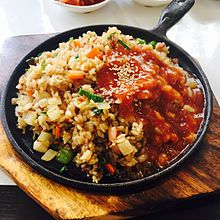

 | |
| Alternative names | Fried rice |
|---|---|
| Type | Bokkeum (stir-fried dish) Fried rice |
| Place of origin | Korea |
| Associated cuisine | Korean |
| Main ingredients | Bap (cooked rice) |
| Variations | Kimchi-bokkeum-bap (kimchi fried rice) |
| Similar dishes | Chāhan, chǎofàn, khao phat, nasi goreng |
| Korean name | |
| Hangul | 볶음밥 |
|---|---|
| Revised Romanization | bokkeum-bap |
| McCune–Reischauer | pokkŭm-pap |
| IPA | [po.k͈ɯm.bap̚] |
Bokkeum-bap (Korean: 볶음밥) or fried rice is a Korean dish made by stir-frying bap (cooked rice) with other ingredients in oil.[1] The name of the most prominent ingredient other than cooked rice often appears at the very front of the name of the dish, as in kimchi-bokkeum-bap (kimchi fried rice).
In Korean restaurants, fried rice is a popular end-of-meal add-on. Diners may say "bap bokka juseyo" (밥 볶아 주세요. literally "Please fry rice."[2]) after eating main dishes cooked on a tabletop stove, such as dak-galbi (spicy stir-fried chicken) or nakji-bokkeum (stir-fried octopus), then cooked rice along with gimgaru (seaweed flakes) and sesame oil will be added directly into the remains of the main dish, stir-fried and scorched.
The name of the most prominent ingredient other than cooked rice often appears at the very front of the name of the dish. Kimchi-bokkeum-bap (kimchi fried rice), beoseot-bokkeum-bap (mushroom fried rice), saeu-bokkeum-bap (shrimp fried rice) are some examples. When there is no main or special ingredient, the dish is usually called either bokkeum-bap (fried rice) or yachae-bokkeum-bap (vegetable fried rice).
Korean Chinese fried rice, often called junggukjip bokkeum-bap (중국집 볶음밥; "Chinese restaurant fried rice") in South Korea,[3] is characterized by the smoky flavor from the use of wok on high heat, eggs scrambled or fried in the scallion-infused oil, and the jajang sauce (a thick black sauce used in jajangmyeon) served with the dish.
Another popular dish, cheolpan-bokkeum-bap (철판 볶음밥; "iron griddle fried rice") is influenced by the style of Japanese teppanyaki.[citation needed] The Japanese word teppan (鉄板; "iron griddle") and the Korean word cheolpan (철판; "iron griddle") are cognates, sharing the same Chinese characters.